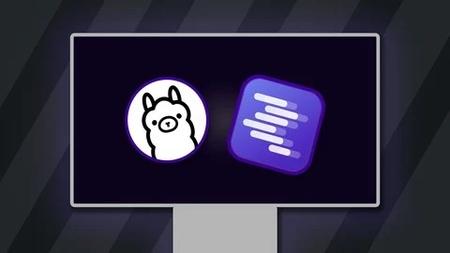English | MP4 | AVC 1920×1080 | AAC 44KHz 2ch | 57 lectures (3h 54m) | 722 MB
Run open large language models like Gemma, Llama or DeepSeek locally to perform AI inference on consumer hardware.
Unlock the Power of Private, Powerful AI on Your Own PC!
ChatGPT, Google Gemini and all those other AI chatbots are standard tools for everyday use. But like all tools, they’re not the best choices for all tasks.
When privacy, cost, offline access, or deep customization matter, running powerful open models locally on your own computer beats all those proprietary models and third-party AI chatbots.
This course will teach you how to leverage open LLMs like Meta’s Llama models, Google’s Gemma models or DeepSeek models to run AI workloads and AI chatbots right on your machine – no matter if it’s a high-end PC or a normal laptop.
Why Local & Open LLMs?
In an era dominated by cloud-based AI and chatbots like ChatGPT, running state-of-the-art models locally offers game-changing advantages. Imagine leveraging cutting-edge AI with:
- Zero or Low Cost: Forget expensive subscriptions; tap into powerful models freely.
- 100% Privacy: Your prompts and data stay securely on your machine – always.
- Offline First: Operate powerful AI tools anytime, anywhere, no internet required.
- Freedom from Vendor Lock-in: Access a diverse and rapidly growing ecosystem of open models.
- Astonishing Capability: Discover how open models like Gemma, Llama, and DeepSeek are not just alternatives, but top performers, ranking high on benchmarks and the Chatbot Arena leaderboard!
This course is your comprehensive, hands-on journey into the practical world of local LLMs. We’ll cut through the complexity, guiding you step-by-step from setup to advanced usage.
Here’s what you’ll master:
- The Open LLM Landscape: Understand what open models are and why they matter (and where to find them).
- Hardware Demystified: Learn the realistic hardware requirements for running LLMs locally.
- Quantization Explained: Uncover the technique that makes running huge models feasible on consumer hardware.
- LM Studio In-Depth: Get hands-on with installing, configuring, selecting, downloading, and running models using LM Studio.
- Ollama Mastery: Learn to install, configure, and interact with models seamlessly via Ollama.
- Real-World Use Cases: Apply your knowledge to practical tasks like image OCR (reading text from images), summarizing PDF documents, mastering few-shot prompting, and generating creative content.
- Programmatic Power: Discover how to integrate these locally running models into your own scripts and applications using their built-in APIs (LM Studio & Ollama).
- And much more! Build a solid foundation and gain the confidence to explore the vast potential of local AI.
What you’ll learn
- Explore & understand Open-LLM use-cases
- Achieve 100% privacy & agency by running highly capable open LLMs locally
- Select & run open LLMs like Gemma 3 or Llama 4
- Utilize Ollama & LM Studio to run open LLMs locally
- Analyze text, documents and images with open LLMs
- Integrate locally running open LLMs into custom AI-powered programs & applications
Table of Contents
1 Welcome To The Course!
2 What Exactly Are “Open LLMs”?
3 Why Would You Want To Run Open LLMs Locally?
4 Popular Open LLMs – Some Examples
5 Where To Find Open LLMs?
6 Running LLMs Locally – Available Options
7 Check The Model Licenses!
8 Module Introduction
9 LLM Hardware Requirements – First Steps
10 Deriving Hardware Requirements From Model Parameters
11 Quantization To The Rescue!
12 Does It Run On Your Machine?
13 Module Introduction
14 Running Locally vs Remotely
15 Installing & Using LM Studio
16 Finding, Downloading & Activating Open LLMs
17 Using the LM Studio Chat Interface
18 Working with System Prompts & Presets
19 Managing Chats
20 Power User Features For Managing Models & Chats
21 Leveraging Multimodal Models & Extracting Content From Images (OCR)
22 Analyzing & Summarizing PDF Documents
23 Onwards To More Advanced Settings
24 Understanding Temperature, top_k & top_p
25 Controlling Temperature, top_k & top_p in LM Studio
26 Managing the Underlying Runtime & Hardware Configuration
27 Managing Context Length
28 Using Flash Attention
29 Working With Structured Outputs
30 Using Local LLMs For Code Generation
31 Content Generation & Few Shot Prompting (Prompt Engineering)
32 Onwards To Programmatic Use
33 LM Studio & Its OpenAI Compatibility
34 More Code Examples!
35 Diving Deeper Into The LM Studio APIs
36 Module Introduction
37 Installing & Starting Ollama
38 Finding Usable Open Models
39 Running Open LLMs Locally via Ollama
40 Adding a GUI with Open WebUI
41 Dealing with Multiline Messages & Image Input (Multimodality)
42 Inspecting Models & Extracting Model Information
43 Editing System Messages & Model Parameters
44 Saving & Loading Sessions and Models
45 Managing Models
46 Creating Model Blueprints via Modelfiles
47 Creating Models From Modelfiles
48 Making Sense of Model Templates
49 Building a Model From Scratch From a GGUF File
50 Getting Started with the Ollama Server (API)
51 Exploring the Ollama API & Programmatic Model Access
52 Getting Structured Output
53 More Code Examples!
54 Roundup
Resolve the captcha to access the links!
